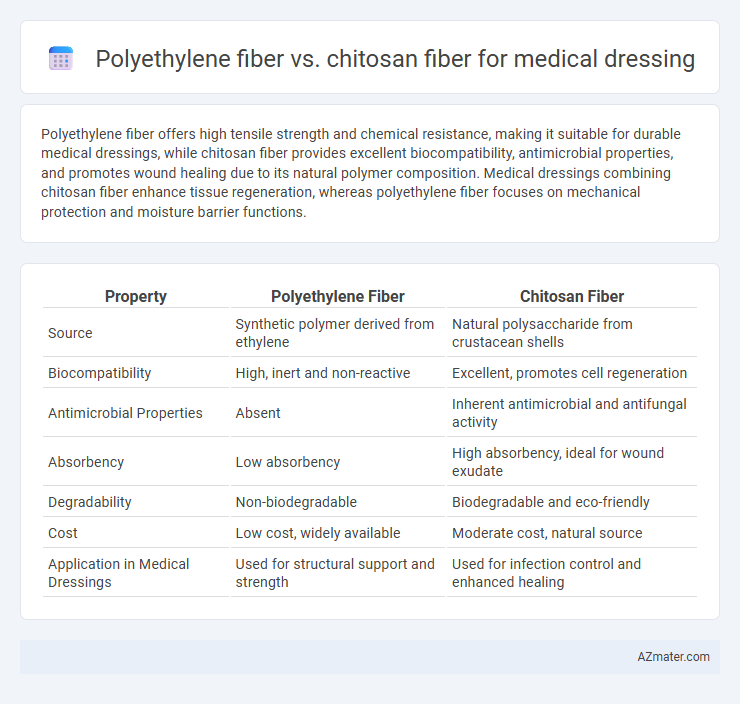Polyethylene fiber offers high tensile strength and chemical resistance, making it suitable for durable medical dressings, while chitosan fiber provides excellent biocompatibility, antimicrobial properties, and promotes wound healing due to its natural polymer composition. Medical dressings combining chitosan fiber enhance tissue regeneration, whereas polyethylene fiber focuses on mechanical protection and moisture barrier functions.
Table of Comparison
| Property | Polyethylene Fiber | Chitosan Fiber |
|---|---|---|
| Source | Synthetic polymer derived from ethylene | Natural polysaccharide from crustacean shells |
| Biocompatibility | High, inert and non-reactive | Excellent, promotes cell regeneration |
| Antimicrobial Properties | Absent | Inherent antimicrobial and antifungal activity |
| Absorbency | Low absorbency | High absorbency, ideal for wound exudate |
| Degradability | Non-biodegradable | Biodegradable and eco-friendly |
| Cost | Low cost, widely available | Moderate cost, natural source |
| Application in Medical Dressings | Used for structural support and strength | Used for infection control and enhanced healing |
Introduction to Medical Dressing Materials
Polyethylene fiber and chitosan fiber serve distinct roles in medical dressing materials due to their unique properties. Polyethylene fiber is valued for its durability, moisture resistance, and non-reactivity, making it suitable for protective wound covers that require long-lasting barrier functions. Chitosan fiber, derived from natural biopolymers, offers antimicrobial activity and promotes wound healing through its biocompatibility and biodegradability, enhancing tissue regeneration in medical dressings.
Overview of Polyethylene Fiber
Polyethylene fiber is widely used in medical dressings due to its excellent tensile strength, chemical resistance, and biocompatibility, ensuring durability and safety in wound care applications. Its hydrophobic nature allows effective moisture barrier properties, preventing external contamination while maintaining breathability to promote healing. Compared to chitosan fiber, polyethylene fiber offers superior mechanical stability but lacks intrinsic antimicrobial activity, often requiring combination with other bioactive materials for enhanced therapeutic effects.
Overview of Chitosan Fiber
Chitosan fiber, derived from chitin found in crustacean shells, exhibits exceptional biocompatibility, biodegradability, and antimicrobial properties, making it highly suitable for medical dressings. Unlike polyethylene fiber, which is synthetic and lacks innate biological activity, chitosan fibers actively promote wound healing by enhancing cell proliferation and reducing infection risks. These advantages position chitosan fiber as a superior choice for advanced wound care materials in medical applications.
Biocompatibility Comparison
Chitosan fiber exhibits superior biocompatibility compared to polyethylene fiber due to its natural origin, biodegradability, and intrinsic antimicrobial properties that promote cell adhesion and wound healing. Polyethylene fiber, while mechanically strong and chemically inert, lacks bioactivity and may provoke foreign body reactions or prolonged inflammation in medical dressing applications. The bioactive nature of chitosan fibers supports enhanced tissue regeneration and reduced risk of infection, making them preferable for advanced wound care products.
Absorbency and Moisture Management
Polyethylene fiber exhibits low absorbency and limited moisture management, often resulting in poor fluid retention and potential skin irritation in medical dressings. In contrast, chitosan fiber offers superior absorbency due to its hydrophilic nature, enabling efficient moisture management and maintaining a moist wound environment critical for healing. The antimicrobial properties of chitosan further enhance its suitability for medical dressings by reducing infection risks while simultaneously managing exudate effectively.
Antimicrobial Properties
Chitosan fiber exhibits superior antimicrobial properties compared to polyethylene fiber due to its inherent biocompatibility and ability to disrupt microbial cell membranes, making it highly effective in preventing infections in medical dressings. Polyethylene fiber, while commonly used for its mechanical strength and durability, lacks intrinsic antimicrobial activity and often requires additional agents to achieve similar protective effects. The natural antimicrobial efficacy of chitosan fibers enhances wound healing and reduces the risk of microbial colonization, positioning them as a preferred material for advanced medical dressings.
Mechanical Strength and Durability
Polyethylene fiber exhibits superior mechanical strength and durability, making it highly resistant to tearing and deformation in medical dressing applications. Chitosan fiber offers biocompatibility and antimicrobial properties but generally has lower tensile strength and faster degradation rates compared to polyethylene. The robust mechanical performance of polyethylene fibers ensures long-lasting support and structural integrity in wound care, whereas chitosan fibers prioritize biological functionality over durability.
Biodegradability and Environmental Impact
Polyethylene fiber, commonly used in medical dressings, offers durability but lacks biodegradability, leading to persistent environmental pollution after disposal. Chitosan fiber, derived from chitin in crustacean shells, demonstrates excellent biodegradability and antimicrobial properties, making it environmentally sustainable and effective for wound care. The biodegradation of chitosan fibers reduces landfill waste and minimizes ecological impact, positioning them as a preferred choice for eco-friendly medical dressings.
Clinical Applications and Patient Outcomes
Polyethylene fiber offers strong tensile strength and excellent moisture resistance, making it ideal for wound dressings requiring durability and barrier protection in clinical settings. Chitosan fiber, derived from crustacean shells, exhibits inherent antimicrobial properties and enhances tissue regeneration, leading to faster wound healing and reduced infection rates. Clinical studies highlight chitosan fiber dressings improve patient outcomes by promoting hemostasis and reducing inflammation, whereas polyethylene fibers primarily provide structural support in dressings.
Future Perspectives and Innovations
Polyethylene fiber offers excellent mechanical strength and chemical resistance, making it suitable for durable medical dressings, while chitosan fiber provides natural biocompatibility, antimicrobial properties, and enhanced wound healing capabilities. Future innovations aim to develop hybrid dressings combining polyethylene's robustness with chitosan's bioactivity to create advanced therapeutic materials. Research is also focused on nanotechnology integration and smart dressings with controlled drug delivery systems to improve patient outcomes.

Infographic: Polyethylene fiber vs Chitosan fiber for Medical dressing
 azmater.com
azmater.com